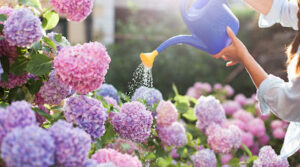The beautiful hydrangea is a staple of gardens all over the world. Their elegant appearance and classic color patterning have made them favorites in homes and on farms for centuries.
This flower’s ability to change colors has led many people to give it whimsical names like “Poor-Man’s-Orchid,” “Honeybells,” and “Big Mama.”
Hydrangea’s quick growth rate and low-maintenance needs have earned it the reputation as the perfect flower you can plant once and then just sit back and enjoy. Although quite easy to grow, the plants do need a little bit of care and attention. To some extent, the level of care will depend on the varieties you choose to plant.
Hydrangea Varieties
There are two main categories of hydrangeas; those that flower on old growth and those that flower on new growth.
- Old-Growth Hydrangeas (Also known as Bigleaf or Mophead): these hydrangea varieties grow from the ground up. They will start flowering when they reach a certain height—usually around one to two years after planting.
- New-Growth Hydrangeas: These varieties flower on the previous year’s growth and kick off the flowering process when new shoots grow from their root system.
- There are several Bigleaf hydrangea varieties that you can choose to plant in your garden, including Oakleaf (Hydrangea quercifolia), Climbing Hydrangeas (Hydrangea anomala petiolaris), and Annabelle (Hydrangea macrophylla “Annabelle”).
- Some of the most popular New-Growth hydrangeas that you can plant in your garden include Peegee Hydrangea (Hydrangea paniculata “Grandiflora”), Climbing Hydrangeas, Oakleaf Hydrangea, and Smooth Hydrangeas (Hydrangea arborescens).
Hydrangea Colors
There are many different species of hydrangeas that have been selected for their flower colors.
You will find an array of blues, purples, reds, pinks, and whites.
- The pink-colored hydrangea species include H. arborescens ‘Annabelle,’ H. macrophylla ‘Bulk,’ H. paniculata ‘Limelight,’ and H. macrophylla ‘Little Lamb.’
- White flowering types include H. arborescens ‘Snowflake’, H. quercifolia, and H. macrophylla ‘Southern Gentleman.’
- Red flowering hydrangeas: H. macrophylla ‘Red Beauty’, H. paniculata ‘Red Baron,’ and H. Serrata ‘Burgundy.’
- Purple flowering type: H. paniculata ‘Limelight’ and H. macrophylla ‘Tea Party.
- Blue Hydrangea plants include H. arborescens, Blue Wave, and H. macrophylla ‘Tardiva’.

Selecting Hydrangea Plants
When choosing the specific hydrangea varieties, you want to plant in your garden, consider their color patterning and how tall they grow.
For example, white flowers tend to work better when planted against dark-colored fences or on a background of dark green trees. This is why Oakleaf Hydrangeas are often used as a backdrop for darker-colored flowers like Roses and Daylilies.
You should also consider your climate and the length of time that you plan to grow your hydrangeas. Some varieties will only flower in certain climates at certain times of year. Thus, they may not even flower when planted outside their ideal conditions.
It’s also worth taking note that these are actually deciduous shrubs and not fragile flowers. Thus, they are relatively sturdy despite the fluffy appearance of the flowers.
When and How to Plant Hydrangea Flowers
- The best time to plant is in the spring; after all, the danger of frost has passed.
- However, you can also plant them in late summer or early fall if there are no freezes expected during that period.
- Dig a hole that is twice as wide and just slightly shallower than the container they are currently in. Then fill the bottom of the planting hole with a mix of composted organic matter and soil from around your garden, so there will be a mixture of nutrients for the roots to soak up.
- Place your hydrangea plant(s) in the ground and backfill with more organic material, making sure that there is a slightly raised mound around the stem of each plant as they will usually produce new roots from where those stems meet the soil surface.
- You also want to ensure that the plants are growing straight, not leaning to one side or another, as this can cause problems later on when they try to grow too large for their allocated space.
- Water thoroughly after planting and continue to do so every few days until the soil becomes moist.
- If you live in a climate where there is snow, make sure to remove any that accumulates over your hydrangea’s buds during winter, or it may die back and not come back next year.
Hydrangea Flowers Care Needs
Hydrangea plants are relatively “unfussy” and need little care once you start them. It’s all about picking the best planting spot!
Soil
- Hydrangeas typically grow best in soil that is finely mulched, well-drained and has a slightly acidic pH.
- If your plants appear to be wilting or not thriving even though they are receiving adequate water, the first thing you should check is the soil’s pH level.
- Add lime to raise the pH level if it is acidic, and add sulfur if the pH level is alkaline.
- A good practice is to constantly monitor the soil pH and make adjustments as needed to ensure that it doesn’t fall below a range of five or go over nine, as this will also damage the plants.
Sun
- Most types of hydrangea grow best in full sun exposure, requiring at least 6-8 hours of sunlight a day. But some will tolerate partial shade.
- For enhanced air circulation and an effective leaf drying process after rain showers, be sure to space the plants adequately.
Water
- These showy flowers need an average of 1 to 2 inches of water per week to thrive and grow into large, healthy bushes.
- If they receive too little water, the blooms will dry up and drop from the stems; they will become droopy and unattractive if they receive too much water.
- Use a soaker hose or drip irrigation to deliver water directly to the plants’ roots, where it’s most effective.

Fertilizer
- Hydrangeas flourish when they are given a slow-release fertilizer every six weeks from spring through fall.
- A high-nitrogen fertilizer will boost blooming by stimulating new growth in the plants.
- However, be careful not to overfeed them as you may end up with full and lush plants with very few blooms.
- Do not fertilize after the blooming period is over unless you want to encourage new growth for next year. Then only use organic fertilizer, as it will be much less harmful than chemicals would be.
Temperature and Humidity
- Hydrangea plants prefer fairly mild temperatures, between 40 and 80 degrees Fahrenheit.
- Too much exposure to cold weather can cause the blooms to drop off of the stems. If this happens, don’t worry – your plants will still grow new blooms in spring.
- If you live in an area where temperatures drop during the winter months, protect your hydrangeas by removing all foliage on their stems and branches and covering them with a thick layer of mulch.
Pruning
- In fall or early spring, prune your hydrangeas to remove dead blooms and stems, crossing stems and branches that grow at odd angles.
- In addition, you should stake tall blooming stalks during the growing season, so they have a chance to become strong enough to hold up the flowers.
Pest control for Hydrangea Plants
- Several different pests can affect these plants, including aphids, Japanese beetles, and spider mites.
- Ladybugs are known to eat aphids but may also be used to prevent spider mites.
- Aphids can also be wiped from the leaves using an alcohol-soaked cotton ball or swab. For other pests, apply insecticidal soap or horticultural oil according to manufacturer instructions.
- Be sure to spray your entire plant, including the undersides of leaves.
The Takeaway: Hydrangea Plants Grow With Little Care When You Plant Them in the Best Location
Choose a sunny location with well-drained soil when you plant your hydrangea. As a result of your effort, you will reap lush, full, colorful, and fragrant blooms in the summertime.

